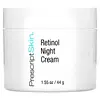What's inside
What's inside
 Key Ingredients
Key Ingredients

 Benefits
Benefits

 Concerns
Concerns

 Ingredients Side-by-side
Ingredients Side-by-side

Water
Skin ConditioningCaprylic/Capric Triglyceride
MaskingGlycerin
HumectantGlyceryl Stearate
EmollientPEG-100 Stearate
Cetyl Alcohol
EmollientStearic Acid
CleansingRetinol
Skin ConditioningDimethicone
EmollientPolysorbate 20
EmulsifyingCarbomer
Emulsion StabilisingHydrolyzed Wheat Protein
Skin ConditioningBHT
AntioxidantBorago Officinalis Seed Oil
EmollientSodium PCA
HumectantRosa Moschata Seed Oil
EmollientDisodium EDTA
Hamamelis Virginiana Extract
AntiseborrhoeicAvena Sativa Kernel Extract
AbrasiveSalix Alba Bark Extract
AstringentPogostemon Cablin Leaf Extract
PerfumingMelaleuca Alternifolia Leaf Oil
AntioxidantSodium Hydroxide
BufferingPhenoxyethanol
PreservativeEthylhexylglycerin
Skin ConditioningCitronellol
PerfumingCoumarin
PerfumingGeraniol
PerfumingLinalool
PerfumingParfum
MaskingWater, Caprylic/Capric Triglyceride, Glycerin, Glyceryl Stearate, PEG-100 Stearate, Cetyl Alcohol, Stearic Acid, Retinol, Dimethicone, Polysorbate 20, Carbomer, Hydrolyzed Wheat Protein, BHT, Borago Officinalis Seed Oil, Sodium PCA, Rosa Moschata Seed Oil, Disodium EDTA, Hamamelis Virginiana Extract, Avena Sativa Kernel Extract, Salix Alba Bark Extract, Pogostemon Cablin Leaf Extract, Melaleuca Alternifolia Leaf Oil, Sodium Hydroxide, Phenoxyethanol, Ethylhexylglycerin, Citronellol, Coumarin, Geraniol, Linalool, Parfum
Water
Skin ConditioningGlycerin
HumectantEthylhexyl Cocoate
EmollientCetyl Alcohol
EmollientHydrogenated Coco-Glycerides
EmollientStearyl Alcohol
EmollientButylene Glycol
HumectantCaprylic/Capric Triglyceride
MaskingButyrospermum Parkii Butter
Skin ConditioningGlyceryl Stearate Citrate
EmollientMacadamia Ternifolia Seed Oil
EmollientOctyldodecanol
EmollientUbiquinone
AntioxidantRetinyl Palmitate
Skin ConditioningTocopherol
Antioxidant1,2-Hexanediol
Skin ConditioningDehydroacetic Acid
PreservativeCarbomer
Emulsion StabilisingSodium Hydroxide
BufferingTrisodium EDTA
Water, Glycerin, Ethylhexyl Cocoate, Cetyl Alcohol, Hydrogenated Coco-Glycerides, Stearyl Alcohol, Butylene Glycol, Caprylic/Capric Triglyceride, Butyrospermum Parkii Butter, Glyceryl Stearate Citrate, Macadamia Ternifolia Seed Oil, Octyldodecanol, Ubiquinone, Retinyl Palmitate, Tocopherol, 1,2-Hexanediol, Dehydroacetic Acid, Carbomer, Sodium Hydroxide, Trisodium EDTA
Ingredients Explained
These ingredients are found in both products.
Ingredients higher up in an ingredient list are typically present in a larger amount.
This ingredient is an emollient, solvent, and texture enhancer. It is considered a skin-softener by helping the skin prevent moisture loss.
It helps thicken a product's formula and makes it easier to spread by dissolving clumping compounds.
Caprylic Triglyceride is made by combining glycerin with coconut oil, forming a clear liquid.
While there is an assumption Caprylic Triglyceride can clog pores due to it being derived from coconut oil, there is no research supporting this.
Learn more about Caprylic/Capric TriglycerideCarbomer is a polymer of acrylic acid. Its main role is to create a gel consistency.
A high amount of carbomer can cause pilling or balling up of products. Don't worry, most products contain 1% or less of carbomer.
Cetyl Alcohol is a fatty alcohol. Fatty Alcohols are most often used as an emollient or to thicken a product.
Its main roles are:
Though it has "alcohol" in the name, it is not related to denatured alcohol or ethyl alcohol.
The FDA allows products labeled "alcohol-free" to have fatty alcohols.
Learn more about Cetyl AlcoholGlycerin is already naturally found in your skin. It helps moisturize and protect your skin.
A study from 2016 found glycerin to be more effective as a humectant than AHAs and hyaluronic acid.
As a humectant, it helps the skin stay hydrated by pulling moisture to your skin. The low molecular weight of glycerin allows it to pull moisture into the deeper layers of your skin.
Hydrated skin improves your skin barrier; Your skin barrier helps protect against irritants and bacteria.
Glycerin has also been found to have antimicrobial and antiviral properties. Due to these properties, glycerin is often used in wound and burn treatments.
In cosmetics, glycerin is usually derived from plants such as soybean or palm. However, it can also be sourced from animals, such as tallow or animal fat.
This ingredient is organic, colorless, odorless, and non-toxic.
Glycerin is the name for this ingredient in American English. British English uses Glycerol/Glycerine.
Learn more about GlycerinSodium Hydroxide is also known as lye or caustic soda. It is used to adjust the pH of products; many ingredients require a specific pH to be effective.
In small amounts, sodium hydroxide is considered safe to use. However, large amounts may cause chemical burns due to its high alkaline.
Your skin has a natural pH and acid mantle. This acid mantle helps prevent harmful bacteria from breaking through. The acid mantle also helps keep your skin hydrated.
"Alkaline" refers to a high pH level. A low pH level would be considered acidic.
Learn more about Sodium HydroxideWater. It's the most common cosmetic ingredient of all. You'll usually see it at the top of ingredient lists, meaning that it makes up the largest part of the product.
So why is it so popular? Water most often acts as a solvent - this means that it helps dissolve other ingredients into the formulation.
You'll also recognize water as that liquid we all need to stay alive. If you see this, drink a glass of water. Stay hydrated!
Learn more about Water